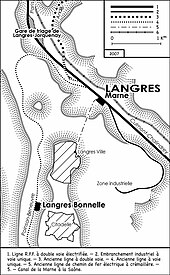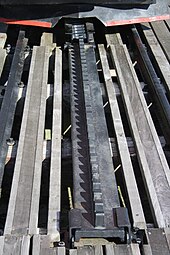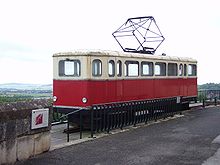Langres rack railway
The Langres rack railway existed between 1887 and 1971 in the French city of Langres , which is located in the Haute-Marne department of the Grand Est region . It was the first rack railway to open in France .
History and description
The fortified city of Langres is situated on a promontory of the plateau Plateau de Langres . Langres-Marne station on the Paris – Mulhouse line , which was put into operation in 1857 by the Chemin de fer de l'Est railway company, is located in the Marne valley , about 130 meters below the town. Until 1887, wagons and carriages operated between the city and the train station. The construction of a railway line from Poinson-lès-Grancey in 1875 did not result in a more conveniently located train station, following the request of the military, the Langres-Bonnelle station (initially called Langres-Ville ) was built at the citadel instead .
The meter-gauge railway with rack of the Riggenbach type was opened on November 6, 1887, between the station, 335 meters above sea level, and a terminal on the edge of the old town . This was preceded in 1873 by an agreement between the state and the railway company to build a railway branch line, but this was never realized. The following project of a double-track funicular railway was not realized either. The Swiss engineer Niklaus Riggenbach , who carried out the planning on site in 1881, had proposed the additional installation of a toothed rack, which should only be used for braking. However, the fact that the train going down the valley was supposed to take up water as ballast in the mountain station and, due to its weight, pull the uphill train up, turned out to be problematic.
In 1882 Riggenbach's concept was modified to the effect that a locomotive and a passenger car should run on one of the two tracks, and a passenger and a freight car on the other. The locomotive was supposed to move the second train on the funicular rope via the pulley in the mountain station. This plan was also filed.
Two years later, the engineer Cadart finally said goodbye to the plans of his predecessors. Instead of a funicular, he designed the single-track route on a modified route. A steam locomotive that was always standing on the valley side was supposed to push the wagons uphill and brake them downhill. On the steep section it should run in gear mode, in less inclined areas in adhesion mode.
Work began on July 9, 1886. The route was 1,472 meters long, overcame a difference in altitude of 132 meters and had a maximum gradient of 172 ‰. The rack of the Riggenbach system was attached in the middle between the Vignol rails on two sections totaling 938 meters long . Of two alternative designs - mountain station in the tunnel or in the open air - the latter was chosen for military reasons. It made it necessary to build a 63 meter long viaduct on brick pillars to bring the track to the top of the fortification wall. A defense tower and other buildings there had to be demolished, other houses were incorporated into the infrastructure of the mountain station. The church of the Dominican monastery, which was acquired for 60,000 francs, was converted into a locomotive and wagon shed with a workshop and warehouse. In the event of a hostile threat, the viaduct should be dismantled quickly and a parapet with battlements can be built at the point of the tower .
The route led in a slight curve on the top of the wall past the former church and ended immediately behind it at today's Place de la Crémaillère . The construction of the mountain station on the outskirts was controversial among the population: it was too far from the center and not appropriate to the beauty of the city. However, a guided tour to the more conveniently located Place des Cours (today: Place Jean Duvet ) turned out to be not feasible, mainly due to the expected higher operating costs.
The stations were single-track, with a small building and a covered platform. In the Gare de Langres valley station , the trains ended up on a stump track on the station forecourt. The depot with the two-track shed was built at the Ville haute mountain station, and another , single-track shed at the valley station. The two train drivers and two stokers were, like the rest of the railway staff, city officials.
Until 1935, the trains were carried by steam locomotives with the slightly inclined boiler facing the wagons facing the valley. The first locomotive arrived on October 15, 1887, and the first test run took place ten days later. A few years later, a third was added to the No. 1 and No. 2 locomotives built in 1886. The machines and cars were built according to plans by Riggenbach at the Société Alsacienne de Construction Mécanique in Belfort . Three independent brake systems (hand brake, air pressure brake and counter pressure brake) were used for safety.
The five passenger cars were two-axle, two of which were open summer cars. They were 2.40 meters wide and 2.90 meters high. On the mountain side, they had open platforms, on each of which stood a brakeman who operated a brake that acted on the rack. Depending on requirements, one to a maximum of two cars were used.
Initially, twenty pairs of trains ran daily, providing connections to and from all long-distance trains. They covered the distance downhill in nine minutes and uphill in ten minutes. Goods were only carried to a modest extent: in 1911, 42 tons of general cargo and luggage were counted, while 386,024 passengers were counted.
In 1902 it was proposed for the first time to use electrically powered vehicles, and in 1928 the track systems were repaired. In 1932 the city council decided to convert the locomotives to oil firing, but no company could be found for this. In the following year, the car manufacturer Renault carried out test drives with buses , but these were unsatisfactory. In June 1933, the decision was made to keep the railway and convert it to electrical operation.
Electrical operation

In 1935 the line was electrified with 600 volts direct current and a substation was built in the depot at the mountain station . The electricity was supplied by a power plant near the valley station. The steam trains were replaced by two four-axle electric railcars on bogies , the old locomotives were scrapped. The new vehicles , 11 meters long, 2.43 meters wide and, with the pantograph lowered, 3.70 meters high, had an empty weight of 12.5 tons. Each of the two engines developed 45 hp , and the outer axles of the two bogies were driven. The cruising speed was 11 km / h, the top speed was 18 km / h. A total of 4.5 tons, i.e. H. The railcars could accommodate fifty passengers and one ton of luggage or a maximum of sixty passengers. In the compartment of first class there were eight, in the 2nd class thirty-two seats. There was also a luggage compartment and a driver's cab at both ends .
A request stop was set up on the slope between the two stations in the Saint-Gilles district , where a discarded car served as a shelter and ticket office. After initial problems that occasionally led to train cancellations, the new vehicles ran reliably and commuted between the endpoints thirty-two times a day. With the beginning of the Second World War , the number of passengers decreased, during the German occupation the traffic was suspended for three months. Shortly before they left, the occupiers dismantled the viaduct, which could soon be rebuilt after the liberation .
In 1945 a third railcar was ordered, which was delivered four years later. This enabled the older vehicles to be fundamentally overhauled between 1949 and 1951. To counteract the decline in passengers due to increasing automobile traffic, buses with a connection to the rack railway were brought to the mountain station from different parts of the city in 1963. Thirty-three pairs of trains ran daily that year. For cost reasons, the valley station building was replaced by a shelter, and tickets were now sold in the long-distance train station.
Cessation of operations
In February 1971 operations were stopped due to obsolescence and the trains were replaced by buses. Two railcars have been preserved, one of which has stood since 1982 on a short section of track with a rack at the upper end of the viaduct, near the location of the former mountain station. The buildings of the mountain station were demolished in 1980, the depot gave way to the expansion of the hospital in 1986.
Inclined elevators
In 1995, two inclined elevators running parallel above ground were put into operation elsewhere , connecting the parking spaces on the slope with a mountain station near the old cog railway station. Elevator Panoramic 1 is 30 meters long , Panoramic 2 is 84 meters long.
gallery
Web links
- Laissez-vous conter la crémaillère de Langres The history of the railway with many pictures (French)
- Route map at amigamaquette.free.fr
- Report about the railway May 1996 (English)
literature
- Gérard Gueniot: La crémaillère de Langres: Premier chemin de fer à crémaillère construit en France . 4th edition. Dominique Guéniot, Langres 2011, ISBN 978-2-9539418-0-7 .
- Le funiculaire de Langres in: La Vie du Rail, No. 884, February 1963, pp. 20-22











